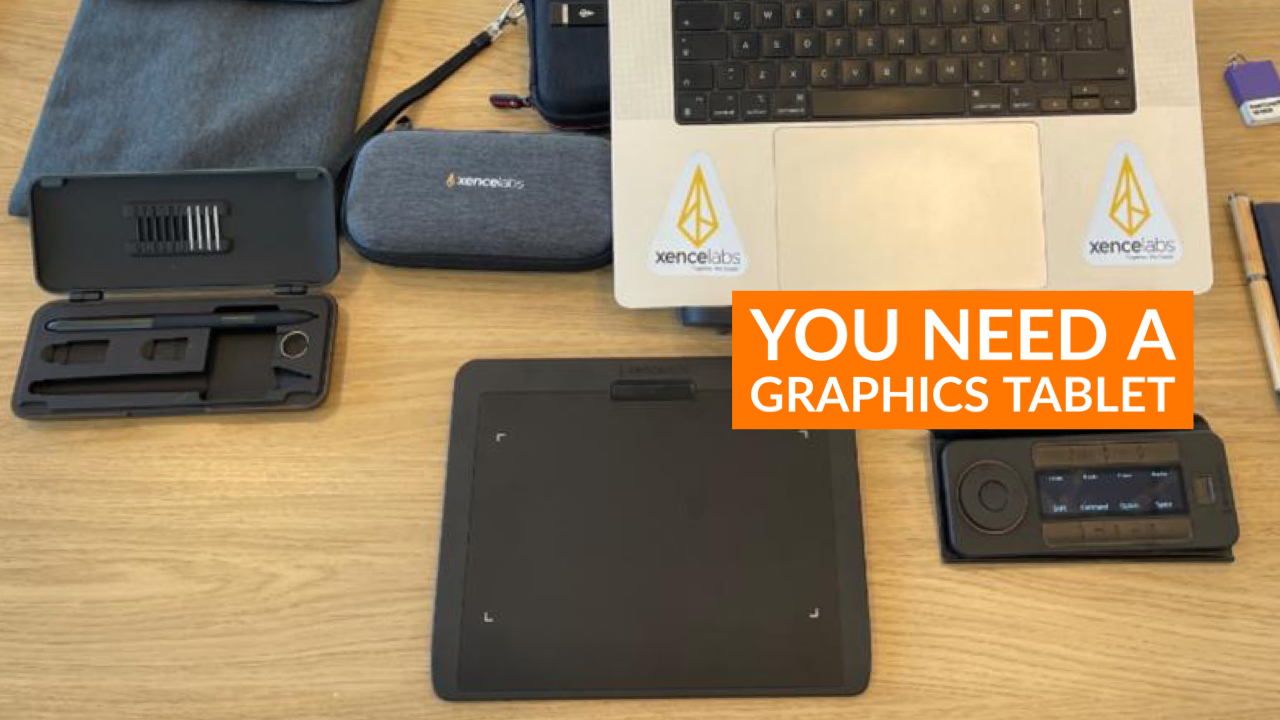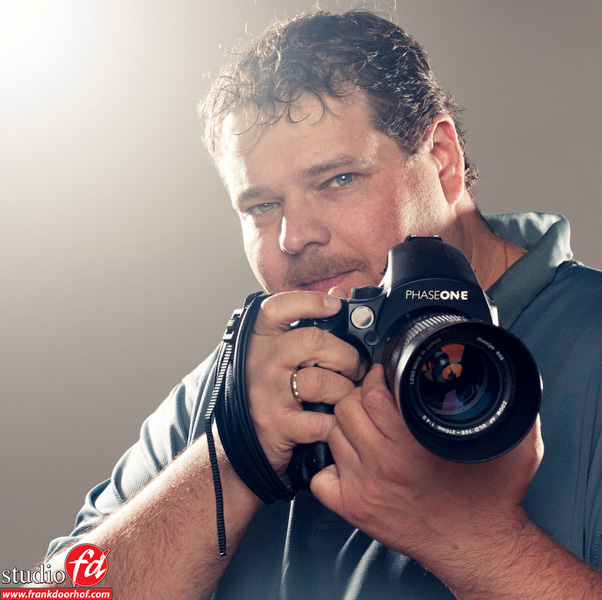
Editor’s Note: This was originally published in 2016, and I thought it would be great to share again along with Frank’s latest KelbyOne course!
A while ago I posted the following online: When you look at carpenters, you will not see them laughing at each other because of the brand of hammer they use. They know it’s all about the work they create, the end result.
Still in almost every workshop I teach, I will have attendees who think they can’t do something because of the camera (or even the brand) they use. In essence it’s all about the work you do, it’s just a tool.
Much to my surprise, some carpenters responded and told me that this was not true and that there are indeed (just like with photography) people that talk down to carpenters using a certain kind of hammer. To say my dream was destroyed goes a bit far but… Well I was actually a bit surprised.
Of course there are fields where gear is incredibly important like biking, racing, etc. that are highly depending on the gear. Fine tuning the car a bit more can be the difference between placing pole position and all the way at the back. The driver is also vital, but sometimes I wonder what the combination is; I think it’s mostly machine “helped” by the human driving it.
Now, with photography I won’t tell you that the gear isn’t important at all. I wish that were the case because that would make our passion a lot lot cheaper! But what I do want to tell you is that the human factor is incredibly important.
Our History
When my wife Annewiek and I were still living in our caves and I came home from the hunt with my dinosaur and could relax while Annewiek was preparing our meat on the BBQ, I couldn’t watch TV so I started drawing on the caves walls. I didn’t draw beautiful women in tiger skins (realize the women back then were also carrying weapons). What I drew were literally stories about my heroic adventures and how I discovered fire and later the wheel. Fast forward to our pyramids and we also used drawing/imaging for story telling.
For me photography is not only story telling, but I do like it if most of my images (if not all) have an element of story telling.
What Is Story Telling?
When you talk about story telling, for a lot of people this means letting the model/sitter do something. Add a REAL element of a story and this is 100% true. I would rather call this a concept shoot, meaning you really tell a story.
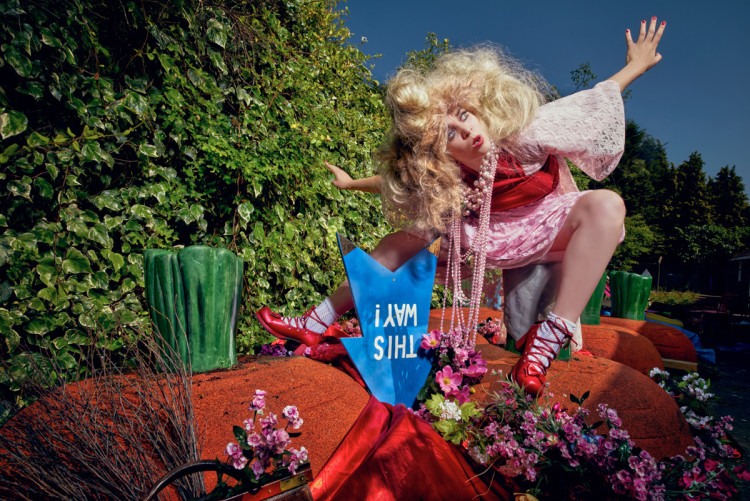
For me story telling is more adding some elements in a shot that make the viewer go, “Mmmm I wonder what he/she is thinking?” or, “What is going on?” It can be done with a simple element like a camera, but it can also be done with something like an expression.
Sometimes people ask me why most of my models look away from the camera. I think this is actually part of that story telling element. If a model looks straight into the camera, this can be incredibly powerful (don’t get me wrong). However it can be even more powerful when the model isn’t. Then the immediate question becomes, “Where is she looking, what’s going on over there?” Hence your story telling element.
You don’t have to write a book with your one image (or more), but just try to give your model something to work with. You can give her a camera in her hand, but you can also make her work that camera like she is taking selfies etc.
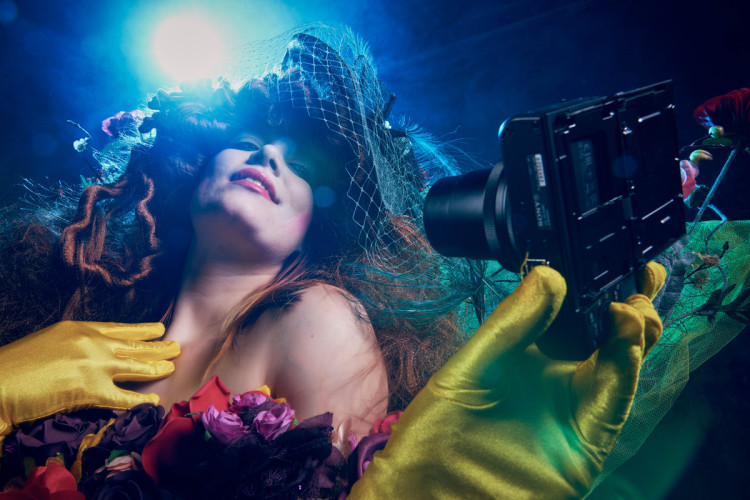
Backgrounds
The story telling can also be with your backgrounds. We all know seamless backgrounds right?
For me they were awesome when I started with my model photography. Then slowly (but surely) they lost a lot of their appeal for the simple reason… There was nothing going on. BUT…. You can use your backgrounds in a totally new way and combine some ideas, and you have a totally different image.
Whenever I teach a workshop where I “have” to use seamless I always ask them if the seamless can be destroyed after the shoot, and luckily they always say yes. I see it as my “trash the dress” shoot. You can actually start very easy.
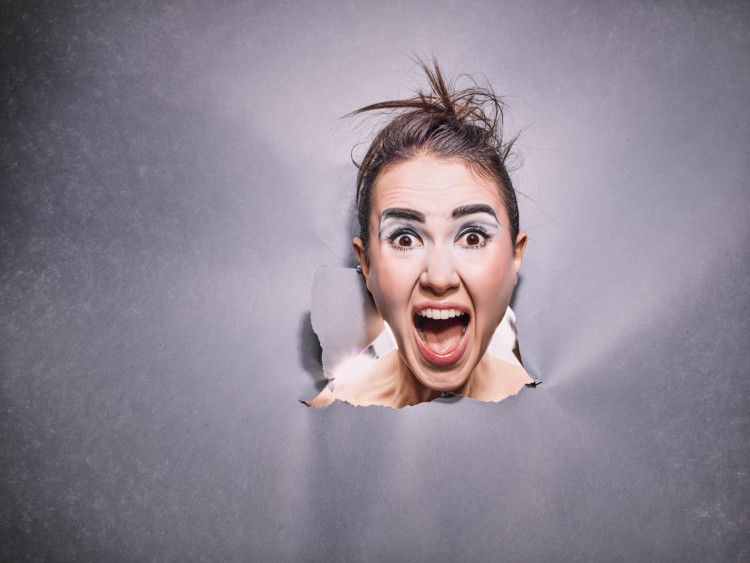
Combining different options really creates something cool in my opinion. For example combine this with the camera.
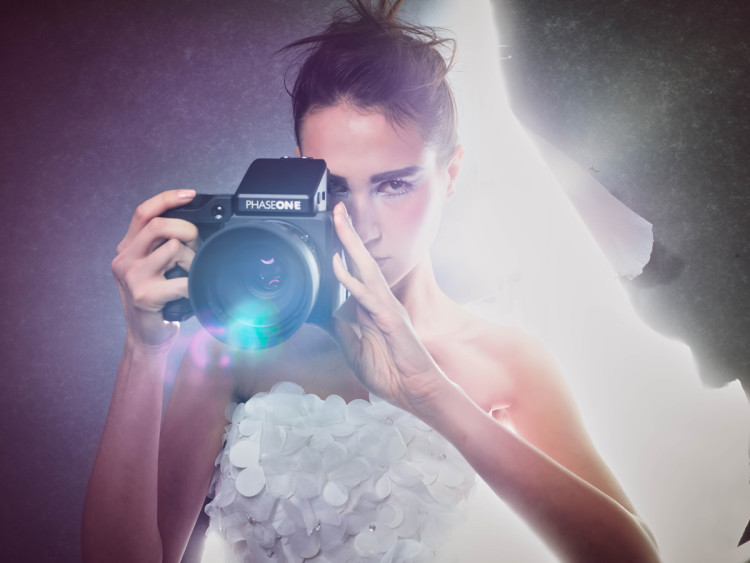
Or let the model do something more….
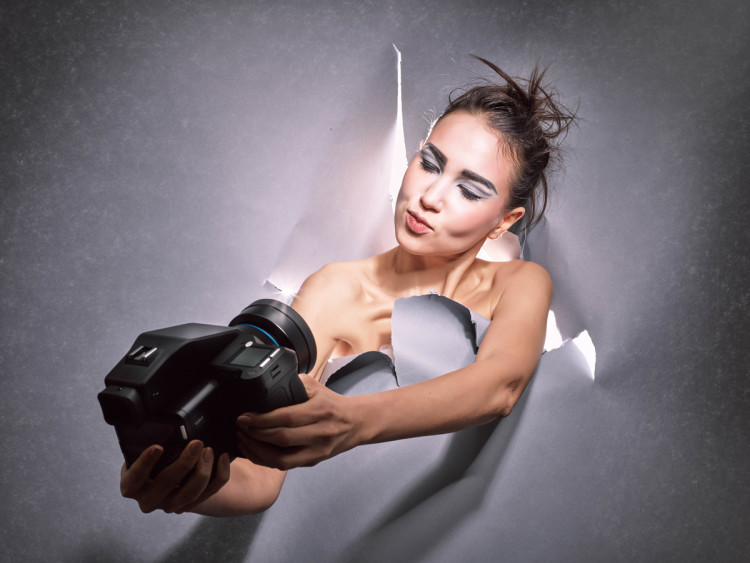
In the end it’s all about your creativity and your mind.
I don’t always work on concept shots because most of the work you see me posting online or find in my portfolio is shot during workshops or during trade shows where I often don’t have the options to do elaborate shoots with big sets. I literally have to work with what I get.
But even then just working with a little bit of styling and proper coaching of your models goes a LONG way.
As you can see in this example, it’s a shot that isn’t hard to create, it’s just in our studio. But I’ve added some smoke to blend everything together and I mixed light sources to create a more surreal look. The whole idea of them looking somewhere and the male model holding a “device” makes it a bit more mysterious (story telling). Your mind will fill in the blanks, and the fun thing is… Everyone will do it differently. That’s also why I hardly ever name my images or add stories to them. I think it’s more powerful when the viewer does that. Because your imagination is much stronger than what I can write down.
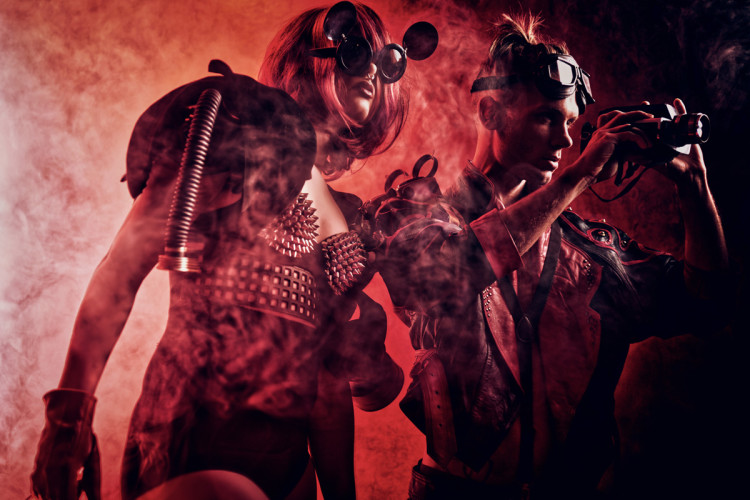
As you see in the example above, although it was just shot during a workshop with the concept of mixing light sources, a BIG part of the image is that you as the photographer determine the outcome. I could have just mixed light sources and explained the effect and technique. But by also pushing myself for a cool shot I also inspire the group to start doing this at home, because they see how “easily” it can be done. Don’t get me wrong… creativity is NOT easy, but it CAN be done.
And sometimes you are just incredibly lucky and everything falls together.
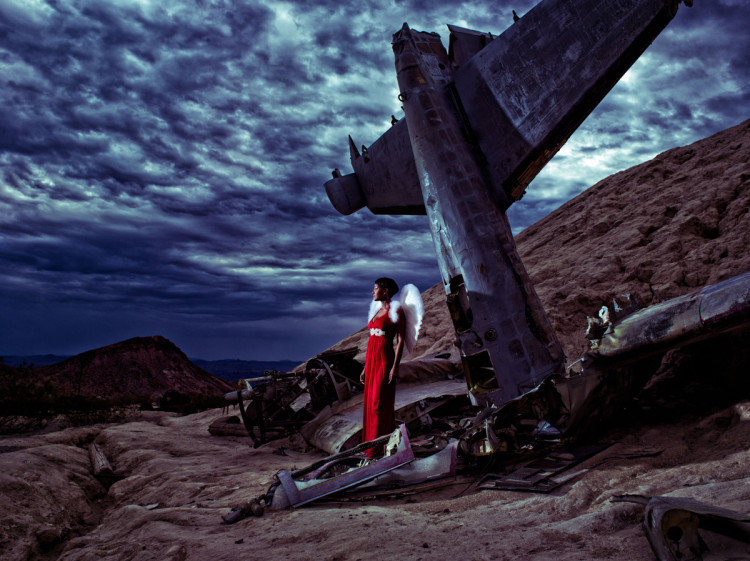
As you can see in the shot above I was very lucky. I shot this just before Photoshop World in Vegas during a trip to Nelson. We brought a model to film a scene for an instructional video. I asked her to bring a red dress, however by happenstance she also brought these angle wings. Lucky me there was a plane, so my mind immediately created… well fill in your own story there (see how easy it is? :D)
Do You Plan?
This is probably the most asked question… And my answer is… Well, yes and no.
Sometimes we plan a shoot and we will plan it from A-Z (and during the shoot it will be different). But we will have an idea for the clothing, location etc. and sometimes… It just happens. Remember that shot we opened with, Nadine sitting on a pumpkin with the sign pointing down? Believe it or not, NOTHING in that shot was planned. It was shot during a workshop I taught in the UK last year and we happened to stumble on this cute little shop creating props for kids attractions. We asked if we could use it for a shot and they said, “Sure but what do you see in this junk?” We just said, “Trust us.” Nadine combined the clothing and literally built the set herself in mere minutes. The only thing I had to do was to “blend” everything together, pose and lighting wise. You don’t want to know how many people ask us how much preparation that shoot took and I think half of them don’t believe the story I just told you, but it’s 100% true.
At one point you develop a sense for story telling.
During the workshops at Photoshop World you will see the same thing, I ALWAYS go in blank, I have a theme and things I want to teach, but everything else is 100% blank. This is also why my workshops and demos are always different, even if I teach two or three in a row.
During the workshop/demo, I guide my group exactly through my thought process and show them what I see/think/feel about a setup and what would work or wouldn’t. The fun/interesting thing to see is how everything is build up and how often we do change things during the shoot.
Now this is during workshops/free work where it’s all about the learning process. If we work for clients this is often too “risky” and I will actually create a moodboard for the team and client and try to stick to that moodboard. What I do always build in is options to change things. If you promise smoke to a client and the smoke machines don’t work or are not allowed you’re…. well…. you know what I mean :D If you however promise the idea/suggestion of smoke you can always solve this by for example using lensflare, breathing on the lens etc. So never pin yourself down too much.
Conclusion
The human mind is a crazy thing. It’s incredibly flexible and creative if triggered, so learn to play with that. But don’t go in like a blind horse, make 100% sure you also have the knowledge to pull things off. Although I’m a very creative shooter I know all my techniques, I know how to meter, how to make sure my color and exposures are correct, I know how to create the effects I need. I hate to rely on the “pffff we pulled that off but I don’t know how.”
During workshops I always tell people to bring everything when they ask me what to bring. It often happens I’m only shooting with a 24-70 the whole workshop and one light source. But it also often happens I’m using a 12-24 and several lights. With creative people you never know. Look at the set and let your imagination go wild, but most of all… If you know something works, use that as a backup and start with something new, something exciting. You can also go back to safe, but if you only shoot what you know will work, you will always end up with the same images.
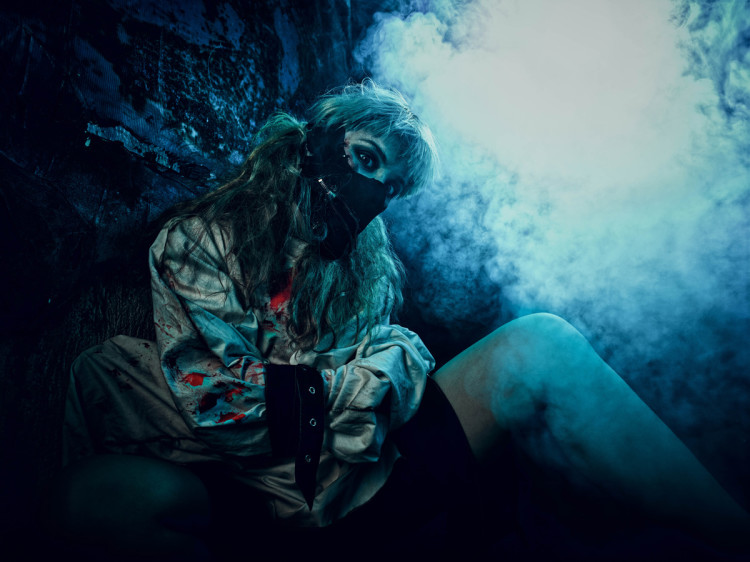
You can see more of Frank’s work at FrankDoorhof.com, and follow him on Instagram, Facebook, Twitter, and YouTube. Check out his latest KelbyOne course, Portrait Photography: One Prop, Unlimited Possibilities for more inspiration!



